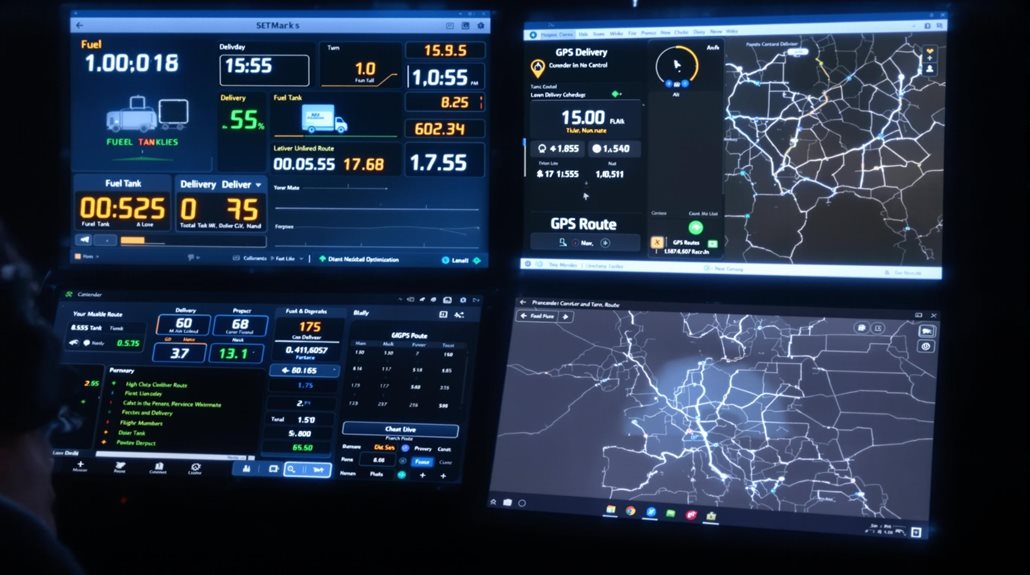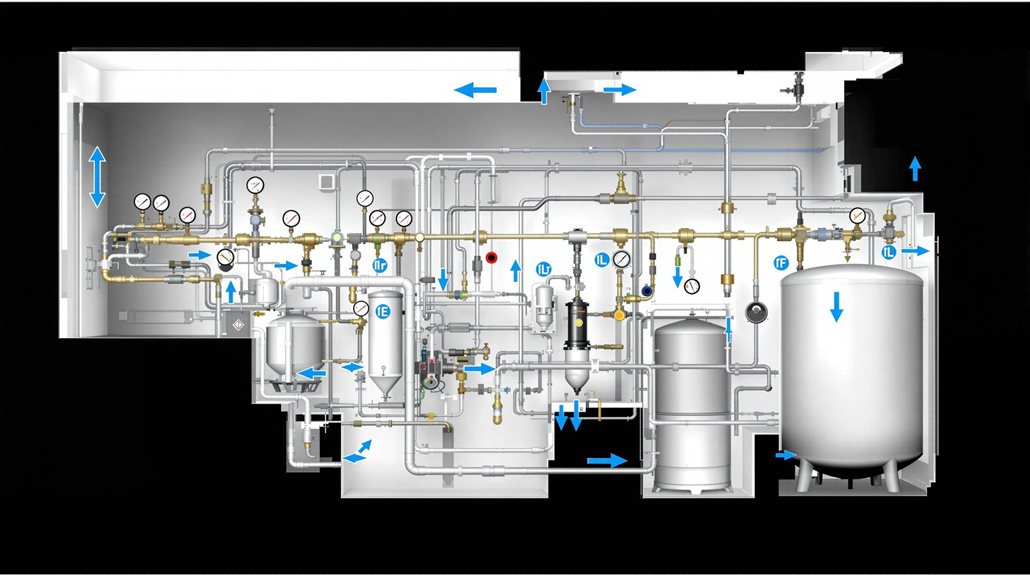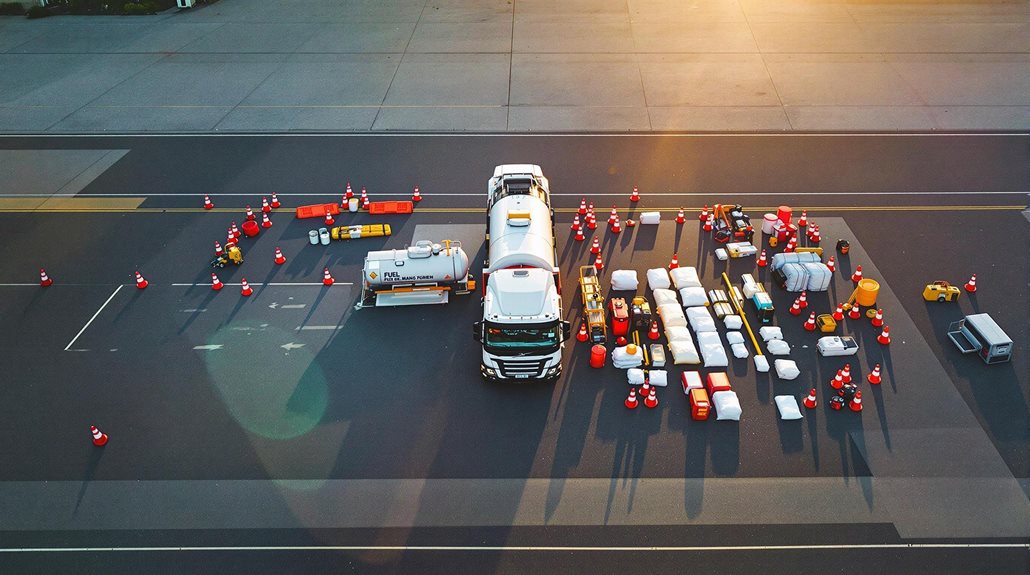Professional fuel delivery operates through a systematic process that prioritizes safety and efficiency. The sequence begins with precise scheduling and site preparation, safeguarding clear access points and proper safety equipment placement. Authorized personnel verify delivery specifications while maintaining continuous communication with suppliers through established protocols. During the transfer, strict safety measures including proper grounding and fire prevention protocols are followed, with spill response equipment readily available. The process incorporates real-time tracking systems and specialized software for route optimization, while thorough documentation ensures regulatory compliance. Understanding these fundamental steps sets the foundation for exploring the intricate details of fuel delivery operations.
Expert Highlights
- Customers schedule fuel delivery through automated systems that track inventory levels and optimize delivery routes.
- Fuel trucks arrive at predetermined times with authorized personnel present to verify and document the delivery.
- Delivery drivers follow strict safety protocols, including grounding equipment and using spill prevention measures during transfer.
- Tank levels are checked before and after delivery, with electronic documentation confirming successful fuel transfer.
- Drivers receive digital confirmation of delivery completion, updating inventory systems and scheduling next delivery windows.
Planning Your Fuel Delivery

Successful fuel delivery hinges on thorough planning and preparation. Organizations must establish precise scheduling protocols, including specified site entrance points and access times, while guaranteeing authorized personnel are available to receive and verify deliveries. Clear signage placement at the site entrance helps guide drivers efficiently to their destination. Maintaining clear communication channels with suppliers is essential for seamless operations. A comprehensive fuel management system helps automate delivery scheduling and inventory tracking.
Effective fuel management requires implementing robust tracking systems to monitor consumption patterns and inventory levels. Organizations should utilize tank monitoring technology to establish reorder thresholds based on usage rates, preventing emergency situations. Additionally, developing inclusive contingency plans, including relationships with alternative suppliers and backup delivery options, safeguards against potential disruptions. Fuel delivery services often provide a variety of fuel types to meet different customer needs.
Regular review and updates of fuel policies, emergency procedures, and site access protocols guarantee the delivery system remains optimized for current operational needs.
Site Preparation Requirements
Proper site preparation for fuel delivery requires careful attention to three critical elements that guarantee smooth operations and safety compliance.
Access points and gates must be clearly marked and unobstructed, while safety equipment should be strategically positioned near delivery zones according to regulatory standards. Clear driveways and pathways must be maintained by removing snow, ice, and any obstacles blocking access to tanks. In Minnesota, reliable 24-hour emergency response services can assist with unexpected interruptions or access issues during fuel delivery. Having site supervisors present during delivery ensures proper tank access and documentation completion.
Site managers must maintain updated personnel contact information and establish clear communication protocols for both routine deliveries and emergency situations.
Access Points and Gates
The strategic placement of access points and gates is fundamental to maintaining a safe and secure fuel delivery operation. Well-designed entry points must accommodate proper spacing requirements, with fueling areas positioned at least 20 feet from ignition sources and vehicles maintaining 10-foot clearances. Security measures, including appropriate signage and controlled access, are essential for operational safety. Each fuel point must have an emergency disconnect control with seal-off fittings installed according to hazardous location requirements.
| Requirement | Specification |
|---|---|
| Distance from Ignition | 20 feet minimum |
| Vehicle Spacing | 10 feet clearance |
| Hose Length | 50 feet maximum |
| Warning Signs | 25 feet from fueling |
Professional fuel delivery operations require precise adherence to these spacing and security protocols. Sites must be properly graded to direct potential spills away from structures and incorporate adequate lighting for nighttime operations, ensuring safe navigation and ideal visibility during fueling procedures.
Safety Equipment Placement
Strategic placement of safety equipment forms the cornerstone of effective site preparation for fuel delivery operations. Fire extinguishers rated at least 4A, 40BC must be positioned within easy reach of personnel, while smoke detectors and fire alarms require installation near storage tanks to enable swift response during emergencies.
Essential safety equipment includes ideal spill response kits strategically located near fuel transfer points, along with proper grounding and bonding cables to mitigate static electricity risks. Emergency contact information must be prominently displayed, and all equipment should remain unobstructed for immediate access.
Fire suppression systems and emergency response equipment must be regularly inspected and maintained according to specifications, ensuring prime functionality when needed. Personnel require thorough training in the proper utilization of all safety equipment and emergency protocols.
Personnel Contact Information
Maintaining accurate and readily accessible personnel contact information stands as a critical requirement for fuel delivery site preparation. A thorough contact system must include current names, titles, and multiple communication methods for all key personnel involved in the delivery process. Site operators should establish both primary and secondary emergency contacts while implementing clear protocols for delivery scheduling and updates.
The contact management system should utilize a centralized database that maintains detailed records of all site-specific information, including physical addresses, delivery points, and special access requirements. Periodic reviews and updates of this information guarantee operational efficiency and minimize potential communication breakdowns. Site administrators must verify that all contact details remain current and easily accessible to authorized personnel through established communication channels.
Scheduling the Right Time

Successful fuel delivery operations depend heavily on precise scheduling that aligns with customer needs while maximizing operational efficiency. Companies utilize advanced route optimization software to calculate the most efficient delivery patterns, incorporating factors such as seasonal demand fluctuations, traffic patterns, and vehicle capacity constraints.
Delivery windows are strategically established based on customer requirements and operational capabilities, with special consideration given to peak usage periods and emergency delivery needs. The scheduling process integrates buffer times between deliveries to accommodate unexpected delays while maintaining reliable service levels.
Modern fuel delivery operations employ real-time tracking systems and mobile applications to provide dynamic route adjustments and instant updates, ensuring that drivers can adapt quickly to changing conditions while maintaining ideal delivery sequences. The 24/7 availability of services such as car jump start ensures that customers receive assistance at any time, complementing the fuel delivery scheduling with continuous roadside support in locations like the Twin Cities.
Safety Measures During Delivery
Safety lies at the heart of every fuel delivery operation, requiring meticulous attention to detailed protocols and procedures. Before delivery commences, thorough site inspections verify proper ventilation and absence of ignition sources, while tank levels are assessed to determine precise delivery quantities. The surrounding area must remain clear of vehicular traffic to guarantee unobstructed operations.
During the transfer process, approved equipment and containers are essential, with careful attention paid to connection integrity and proper grounding to prevent static electricity buildup. The driver maintains a vigilant position near the flow valve, ready to initiate emergency protocols if necessary. Strategic placement of fire extinguishers and spill response equipment provides additional safety assurance. In emergency situations, availability of roadside assistance services can aid in ensuring timely intervention and safety of the site.
Post-delivery procedures include securing fill caps, clear fuel-type marking, and exhaustive documentation of the completed safety checks.
The Fuel Transfer Process

The fuel transfer process encompasses several critical stages that must be executed with precision to guarantee efficient and secure delivery. During the transfer, operators meticulously connect hoses with proper tightening procedures, while strategically placing collection buckets and drip trays beneath critical connection points to prevent environmental contamination. Throughout the operation, the delivery professional conducts thorough inspections of the vehicle's lowermost drain and outlets, making necessary adjustments to prevent leakage. Remember that using professional tire change service can also prevent potential accidents and costly repairs by ensuring all equipment and procedures are executed correctly. Once the primary transfer is complete, the system undergoes a careful drainage procedure, where remaining fuel in the lines is either gravity-fed or pumped into the receiving tank. The process concludes with an extensive visual inspection of the delivery area, ensuring no releases have occurred and all equipment has performed as intended.
Post-Delivery Steps
Following a completed fuel delivery, attention shifts to a structured series of post-delivery procedures that maintain operational integrity and regulatory compliance. These procedures encompass thorough documentation of tank measurements, verification of received fuel quantities against delivery documentation, and detailed updates to inventory records. Businesses located in bustling neighborhoods like Dinkytown MN(#), which is known for its vibrant student life and eclectic mix of shops, benefit from efficient delivery processes to ensure continuous operations. The process continues with securing the delivery area, which involves disconnecting hook-ups, properly locking fill ports, and returning safety equipment to designated storage locations. Facility personnel must then inspect and replenish spill response kits, guaranteeing all safety materials remain readily available for future use. The final phase includes administrative tasks such as coordinating with suppliers, reviewing delivery processes, updating scheduling systems, and reconciling financial records. This systematic approach ensures accurate record-keeping and preserves operational efficiency for future deliveries.
Emergency Response Guidelines

When responding to a fuel delivery emergency, personnel must follow a strict sequence of first response procedures that begin with immediately notifying station staff and local emergency services while securing the affected area.
Having readily accessible emergency contact information for first responders, environmental agencies, and hazmat teams is essential for swift and coordinated action during fuel-related incidents.
The establishment of clear communication channels and predetermined response protocols guarantees that all necessary parties can be contacted and mobilized efficiently when time is of the essence.
First Response Steps
Safety protocols during fuel emergencies require a systematic approach to protect lives, property, and the environment. First responders must approach the scene from upwind or uphill positions, maintaining a safe distance while identifying potential hazards through placards, shipping documents, and Material Safety Data Sheets.
The response process involves securing the affected area by establishing isolation zones and barricades to prevent unauthorized access. Responders must thoroughly assess the situation, evaluating weather conditions, terrain features, and identifying at-risk elements.
Critical considerations include determining the type and quantity of fuel involved, presence of fires or leaks, and available resources for containment. Emergency personnel should consult the DOT Emergency Response Guidebook while ensuring all emergency equipment remains accessible and operational throughout the response effort.
Key Emergency Contacts
Maintaining an organized system of emergency contacts serves as the backbone of effective fuel delivery crisis management. A thorough contact directory should include administration leadership, emergency response coordinators, and environmental health specialists who can immediately address safety concerns during fuel-related incidents.
The contact framework must incorporate external response partners, including local EMS, fire departments, and law enforcement agencies, alongside designated roles such as the Incident Commander and Public Information Officer. Documentation should be maintained in both digital and physical formats, stored in easily accessible locations, and updated regularly.
The Emergency Operations Center serves as the central coordination point, while the Joint Information Center guarantees consistent communication across all channels during fuel delivery emergencies.
Roadside Assistance FAQ
How Long Does a Typical Fuel Delivery Take From Start to Finish?
A standard fuel delivery typically takes 45-60 minutes, including safety checks, tank preparation, fuel dispensing, and completion paperwork. Factors like tank size and site conditions may affect duration.
What Happens if the Delivery Truck Breaks Down En Route?
When a fuel delivery truck breaks down, drivers immediately activate emergency protocols, secure the cargo, notify dispatch, and coordinate a replacement vehicle while following strict safety procedures for hazardous materials.
Can Fuel Be Delivered During Severe Weather Conditions?
Yes, fuel delivery services operate 24/7 during severe weather through specialized equipment and trained drivers, though safety protocols and environmental conditions may affect delivery times and accessibility.
What Payment Methods Are Typically Accepted for Fuel Deliveries?
We accept multiple convenient payment options including credit cards, cash, checks, and money orders through online platforms, in-person transactions, mail-in payments, and phone-based credit card processing.
How Much Advance Notice Is Required to Cancel a Scheduled Delivery?
Standard fuel delivery cancellations require at least 24 hours' notice, while marine fuel deliveries need 48 hours. Failure to provide timely notice typically results in cancellation fees or additional charges.
